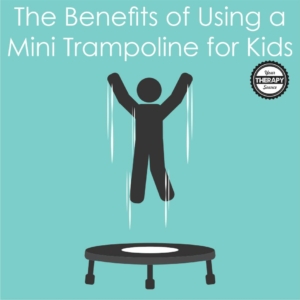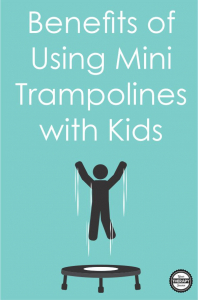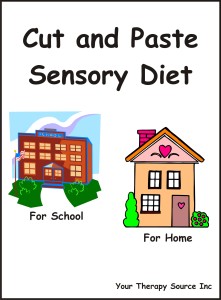Trampoline in Occupational Therapy? Why?
Do you wonder why we use trampolines in occupational therapy, physical therapy sessions, gym class and more with children? Of course, the easiest answer is that they are fun and engaging for kids. It can be an easy way to disguise strengthening and balance exercises. But, there are more reasons than FUN to use trampolines!

Benefits of Using a Mini Trampoline in Occupational Therapy, PT, Gym Class or Home
Of course, safety is of utmost importance whether using a full size trampoline or mini trampolines. Often times, in schools providers use mini trampolines but in a backyard families may have a full size trampoline.
When kids start jumping on trampolines they are working on many skills such as:
- balance
- postural control
- muscle strengthening
- coordination
- jumping skills
- motor planning
- endurance
- sensory input
- aerobic fitness and more!
So playing on trampolines are not just for fun!
What Does the Research Say About Mini Trampoline Use?
When researchers have taken a closer look at children participation in trampoline activities in occupational therapy, PT, PE, or preschool, they have discovered additional benefits.
Postural Control and Mini Trampoline Training
One research study examined the impact of trampoline plyometrics on postural control and jumping height in 24 pre-pubertal children (average age 9.3 years old).
The 24 participants (15 girls and 9 boys) were divided into a trampoline group or a control group. The trampoline group completed 4 weeks of plyometric training on a mini-trampoline (3x/week) during physical education class while the control group participated in the standard PE class. Postural sway and maximum height in countermovement and drop jump were measured before and after the intervention.
The results indicated the following:
- postural sway decreased significantly in normal quiet stance for the trampoline group but not the control group.
- statistically significant decreases in postural sway in the anteroposterior direction during one – leg stance was found for the trampoline group.
- postural sway was unchanged in both directions for the control group.
- statistically significant improvements in jump height were found only for trampoline group after training.
The researchers concluded that training on a mini trampoline could be incorporated into children’s exercise programs to facilitate balance and lower-limb strength.
Reference: Arabatzi, F. (2016). Adaptations in movement performance after plyometric training on mini-trampoline in children. The Journal of sports medicine and physical fitness.
Rebound Exercises and Children with Cerebral Palsy
Another study examined the use of rebound exercises (trampoline and BOSU ball use) in 40 children with spastic diplegia cerebral palsy. The experimental group participated in regular PT sessions and one hour of rebound exercises. The control group participated in the same regular PT sessions but one hour of balance training. Both groups received this intervention for 3 days a week for 2 months.
Following the intervention, the Biodex balance system was use to track improvements. The results indicated a statistically significant improvement of balance in the two groups. There was only a significant difference between post treatment and post 1 month follow-up in the rebound exercise group.
Reference: Abd-Elmonem, A. M., & Elhady, H. S. A. (2018). Effect of rebound exercises on balance in children with spastic diplegia. International Journal of Therapy And Rehabilitation, 25(9), 467-474.
Mini Trampoline Exercises, Executive Functions, and Preschoolers
Another study investigated mini-trampoline physical activity on the development of executive functions (EF) in 57 Chinese
preschool children, ages 3-5 years old. THe children in the intervention and control group had the same classes and care service in the preschool, but children in the intervention group had an extra 20 min of trampoline training after school for 5 school days per week over the 10-week intervention.
Executive function evaluations were used before and after the intervention. Results revealed that no significant differences between the groups following the intervention regarding executive function skills. The researchers recommended future research with larger
samples to determine the dose-response evidence to improve young children’s executive function through physical activity.
Reference: Wen, X., Zhang, Y., Gao, Z., Zhao, W., Jie, J., & Bao, L. (2018). Effect of mini-trampoline physical activity on executive functions in preschool children. BioMed research international, 2018.
Conclusion on Using Trampolines in Occupational Therapy, PT, PE and More
Trampolines are not just fun for kids. They can be a great way to engage children in physical activities and help them build their strength, balance, coordination skills and more!
Trampoline use has many benefits that make it an excellent fun, tool for children to work on their balance and strengthening.
Cut and Paste Sensory Diet: This electronic book includes 2 sensory diet books, one for home and one for school and over 150 picture word cards. My Sensory Diet for School includes daily activities that occur during the school day such as riding the bus, staying in line, floor time, snack, cafeteria, recess and more. My Sensory Diet for Home includes daily activities such as morning time, breakfast, homework, bath, shopping, and more. For each page, there is a daily activity statement with 4 squares to paste the picture word activity cards. The picture word cards include tactile, proprioceptive, vestibular, oral, smell, coordination and balance activities. FIND OUT MORE.





